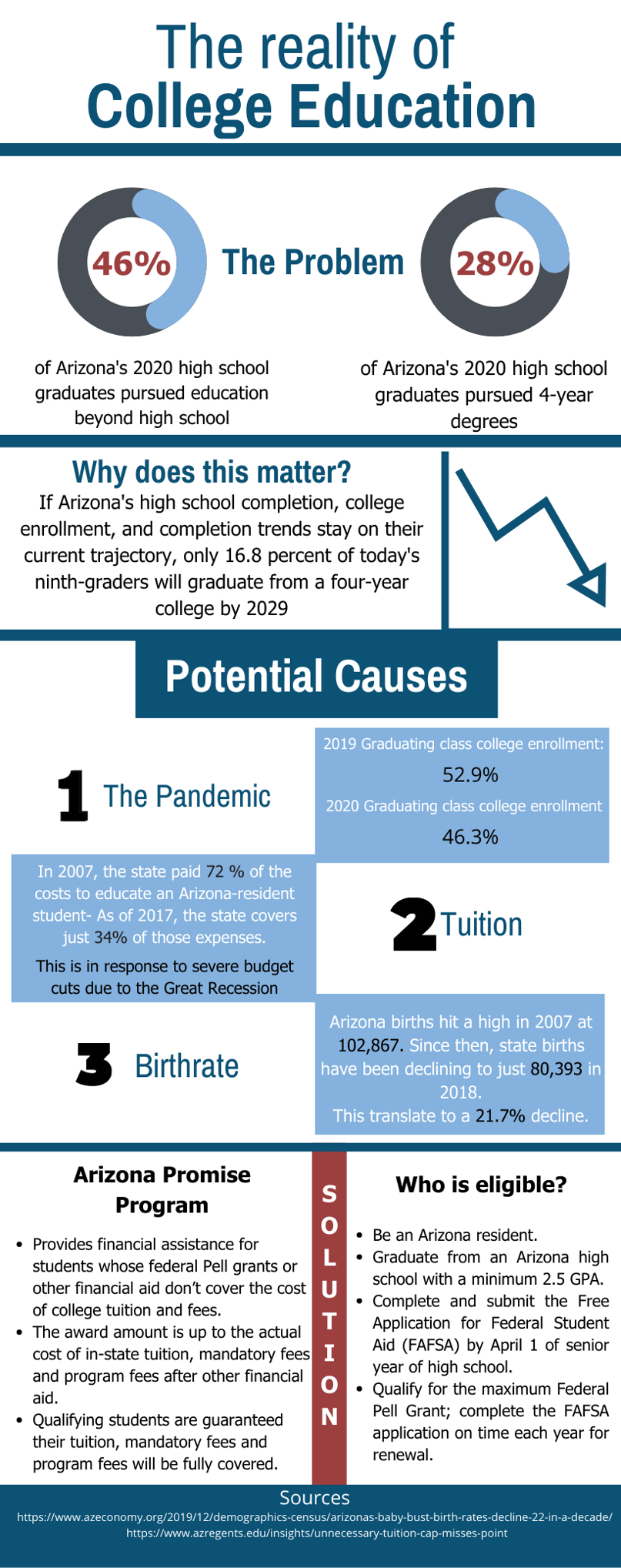Reality of Higher Education in Arizona
- Noble Predictive Insights

- May 5, 2023
- 4 min read
Updated: Jun 25, 2024
The Reality of Higher Education in Arizona
A look into why people are asking “Is college even worth it anymore?”
Families travel near and far to see their loved ones flip that tassel and step off the stage into their next adventure. It’s emotional for many families for a multitude of reasons. For some, they may be first-generation college students, others may have had to work and use every last penny to earn that degree. However, some may never make it to this step…
Let’s take a step back to high school. Arizona’s graduation rate is on track with the national average. Around 87% of Arizonans have obtained at least a high school diploma. Nationally, that number sits at 89%. The unfortunate reality is, according to the U.S. Census Bureau, only 30% of Arizonans have obtained at least a bachelor’s degree.

According to the Arizona Boards of Regents (ABOR), in 2020, less than half (46.3%) of Arizona’s high school graduating class enrolled in a two- or four-year college or other postsecondary institution. This is a noticeable decline from the 52.9% enrollment rate in 2019. Although when the 2019 enrollment rate is compared to the national immediate college enrollment rate for high school graduates in 2019 (66%), it is clear Arizona is trailing behind.
These kinds of statistics spark pursuit of deeper research into the disconnect in the high school to college pipeline. In 2021, the Arizona Board of Regents came to OHPI with the goal of better understanding the attitudes, behaviors, and perceptions of access to higher education, specifically among Arizona's Latino community. This research required the targeting of several very specific audiences, including high school students, recent high school graduates, and parents of students. We were able to assist ABOR by taking a pulse of both parents’ and students’ understanding of the college application process and educational policies, where they need more resources, and how ABOR can curate their materials towards accomplishing the goal of increased Hispanic and Latino college attendance. This powered ABOR’s ability to make data-backed internal decisions and create an informed strategy moving forward.
Arizona is not the only state struggling with higher education attainment. We are seeing this trend across the country. There are more than one million fewer students currently enrolled in college than in early 2020 before the COVID-19 pandemic began sweeping the nation.
Myth or Fact: COVID-19 is the reason for college enrollment decline
As easy as it would be to blame COVID-19 for this decline, this began a few years before the pandemic. Between 2015 and 2018, the share of Americans saying they had a great deal or quite a lot of confidence in higher education dropped from 57% to 48%, and the falloff was greater among Republicans (from 56% to 39%) than among Democrats (68% to 62%).
A 2019 Pew Research Center survey finds that only half of American adults think colleges and universities are having a positive effect on the way things are going in the country these days. About four in ten (38%) say they are having a negative impact – up from 26% in 2012.
It is virtually impossible to narrow down the cause of this decrease to one specific reason. There are several factors leading to this trend, but the most obvious contributor in recent years has been COVID-19.
Let’s face it: College is very expensive and, in some cases, unaffordable for many students and their families. Because of the high cost, some students see community colleges as a better alternative to a four-year institution. Community colleges tend to appeal to lower-income students who are often balancing work, children, and/or other additional responsibilities while still in school.
Lower-income families and people of color are two key demographics that were impacted by the pandemic especially hard. According to the National Student Clearinghouse Research Center, undergraduate enrollment accounted for most of the decline, dropping 4.7% this spring or over 662,000 students from spring 2021
Another reason why college enrollment numbers are declining is the fact that there are simply fewer students. In other words, college enrollments are decreasing because birth rates have gone down. You would think that this is a trend that began during the pandemic, but it has been going on for over a decade now.
The U.S. Census Bureau has found that the national birthrate has steadily been declining since 2008 when families were being devastated by the housing crisis. It largely has not recovered since then, and the pandemic seems to only be making it worse.
“Is college even worth it anymore?”
Many students these days are also beginning to question the value of a college degree, especially when they think about the long-term repercussions of a college education. Is a college degree worth the sleepless nights, increased anxiety, and tens of thousands of dollars in student loan debt? While many older adults saw college degrees as a priority, today’s generation of high school graduates and college students question the point and value of a degree.
The Arizona Promise Program reinforces the idea that Arizona’s continued prosperity depends on having an educated workforce. However, according to ABOR, the current trajectory of Arizona ninth-graders receiving a bachelor’s degree by 2029 is only about 17%.
“With the state’s initial investment in the board’s Arizona Promise Program scholarship, qualifying low-income Arizona students will have their tuition and fees paid in full to attend the Arizona public university of their choice. The value of a university degree has never been higher, and this program represents our promise that cost won’t be a barrier to any deserving Arizona student,” said Regent Larry Penley, Ph.D., treasurer of the board, etc.
Follow us on Twitter, sign up for our Newsletters, and add us on LinkedIn to stay connected.


